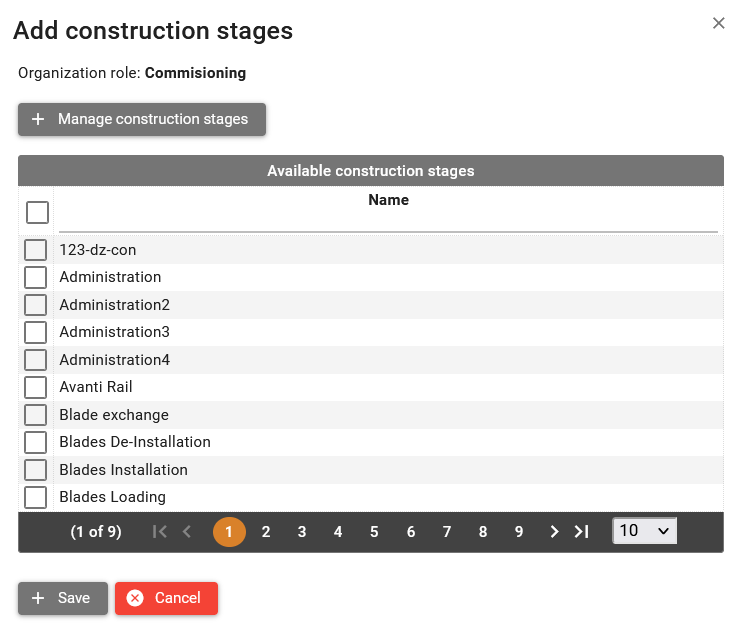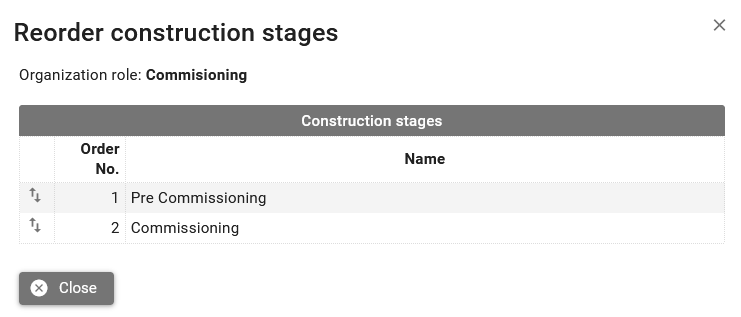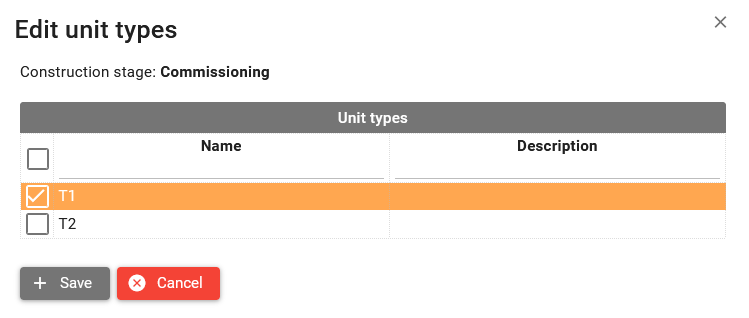Tasks and construction stages
Define your project structure by adding construction stages and tasks that are required to complete the project and assign them to the organization roles. By default, tasks are related to the unit types which means you later will be able to register daily activities against these tasks and units of the type enabled for the task, but you can also define the task to not be related to unit. When project template was selected at the project creation, then you will see project structure copied from the template.
Take your time when defining the project structure to make it correctly. Project structure will later have impact on statistics, estimates and the way the project costs are displayed. Example pitfalls when configuring the project:
-
Tasks that are not needed for unit types are left as enabled - in that case, no activity and progress will be registered for the task and your overall progress for construction stage and later for project will never be 100%. The project estimates will include time to complete that task for all units of that type. Also users can by mistake register some activities against such task and unit of that type.
-
Tasks that are not related to units are left as unit related - in that case users usually register all activities that task against one unit or randomly against different units which will break your progress tracking and may make cost tracking more difficult.
-
Adding one task in SUM-IT which in reality is more than one task - a good example of that will be Mobilization and Demobilization tasks on construction of a wind farm. Users often add one task for that in SUM-IT and name it Mob/Demob despite the tasks are completed in different time and are paid separately by lump sum. As a consequence, there is no way to correctly configure lump sum, track cost and progress in cases like this.

The organization roles names are displayed on the white bar, construction stages name on the black bar, list of the tasks and unit types for them are displayed per construction stage.
- Construction stages in organization role
Define construction stages for organization role.
Adding/removing construction stages
-
Click Add construction stages button to open a dialog allowing to add construction stages to the organization role.
-
Click on the Delete button
to remove construction stage.
Add construction stages dialog
The dialog displays a list of construction stages which are defined in your organization and are not added to selected organization role yet. Select stages you would like to add to organization role and save.
If you need to add new construction stage to your organization, press
Manage construction stages button. The button is visible for users who
have Create/Edit permission on System Management -> Construction Stages functionality.

Reordering construction stages
Click Reorder construction stages button
to open a dialog allowing to reorder
construction stages within the organization role.

Drag and drop construction stages rows in the dialog to reorder them.
- Tasks
Define tasks required to complete the construction stage.
Adding/removing tasks
-
Click Add tasks button to open a dialog allowing to add tasks to the construction stage.
-
Click on the Delete button
to remove the task from the construction stage.
Add tasks dialog
The dialog displays a list of tasks which are defined in your organization and are not added to selected construction stage yet. Select tasks you would like to add to construction stage and save.
If you would like to create new task in organization, press Manage
tasks button. The button is visible for users who have
Create/Edit permission on System Management -> Tasks functionality.

Reordering task
Tasks can be reordered by dragging and dropping them withing a construction stage.
Task settings
In every task row, you have a set of checkboxes to customize the task:
- Enable/disable progress - some tasks are highly unpredictable, or they are so routine that it doesn't feel like there is a need to register the progress for them e.g. daily meetings, lunch breaks. Unselecting the progress checkbox for the task means that no progress will be measured for the it, but you still be able to create an estimates and register an activities against the task.
-
Non unit - selecting the Non unit checkbox for the task means that the task will not be related to any unit in the project. This might be useful when the task is part of a construction stage, but is not part of construction of particular unit e.g.:
-
At the time of offloading parts, we do not know what turbines the parts belong to.
-
Office work, the documentation work, is required to complete the stage, but is not related to any particular unit.
-
A daily meetings is done on every site, but are not related to particular unit.
-
- Enable/disable task for unit type - when you have multiple unit types in your project it may happen that some task are not required to for some of them. In that case disable the task by unselecting checkbox for the unit type:
It can be disabled only if there are no activities registered against that task and units of that type. After disabling, you will not be able to register activities against that task and units of that type.
- Unit types
Unit types are displayed as columns in the construction stage tasks table. By default all unit types defined in the project are displayed for the tasks withing all construction stages.
Removing unit types from construction stage
You can remove unit types which are not required for construction stage by pressing Edit unit types button. That will open the dialog where you can unselect the types which are not required.

- Filtering
Use filter to limit the organization role and construction stages
displayed on the screen.
Reset button clears the filter.